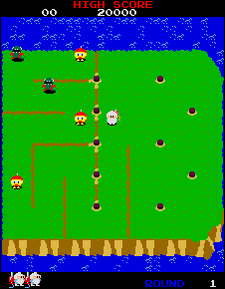Dig Dug II
| Dig Dug II | |
|---|---|
 Screenshot from arcade version | |
| Developer(s) | Namco |
| Platform(s) | Arcade, Famicom/NES, Famicom Disk System, Wii Virtual Console |
| Release | 'Arcade'Famicom/NES'Famicom Disk System'Wii Virtual Console |
| Genre(s) | Action |
| Mode(s) | Up to 2 players, alternating turns |
| Arcade system | Namco Super Pac-Man |
Dig Dug II (ディグダグⅡ, Digu Dagu Tsu), known as Dig Dug II: Trouble in Paradise on the American NES version, is the arcade sequel to Dig Dug, released by Namco in 1985. It runs on Namco Super Pac-Man hardware but with a video system like that used in Mappy. In 2005, it was ported to the PlayStation Portable in Namco Museum Battle Collection and is included in Namco Museum DS released for the Nintendo DS on September 18, 2007 in the United States. It was also included in 2008's Namco Museum Virtual Arcade.
It was also released on the Wii Virtual Console in Japan on October 20, 2009, along with the first game. Both Dig Dug games are available as part of the Namco Museum Megamix compilation for Wii, which, unlike the Virtual Console Arcade versions, was released in North America only.
Gameplay
Unlike the first game, Dig Dug II takes place on an island with an overhead view. The goal is simple: to kill all the enemies on the level. There are two types of enemies; Pookas (the round red monsters with goggles) can kill the player by touching him, but Fygars (the dragons) can kill the player either by breathing fire to burn him or by touching him.
In this game, Taizo Hori (the player's character) is armed with two weapons. One is the pump from the original Dig Dug, which is used to inflate enemies until they burst. The other is a jackhammer, which can be used at dark spots on the map to create faults in the ground. If both ends of a system of faults reach the water, the ground surrounded by them will sink into the ocean, killing all creatures on it, including Taizo himself. The points earned from this depend on how many enemies are killed at once. After level 31, the levels have the same layout as the first 16 levels before it.
When only one, two or (on harder levels) three enemies remains on the map, the enemies will eventually go to the edge of the island and jump off, killing themselves and denying the player points.
The only home version of the game was for the NES, which Bandai released in North America during 1989.
The Namco Museum DS version has a stage select, for levels 1-15. However, only levels 1, 5, 10 and 15 can be selected.
Two versions of Dig Dug II
There are two versions of this game. There is a harder old version, and an easier new version; both versions have completely different levels. The newer version was a lot more common in the arcades than the older version, and almost every port of this game is of the newer version. Both Namco Museum Battle Collection and Namco Museum DS are notable for including both the old version and the new version. The Japanese Wii Virtual Console release has the older version.
